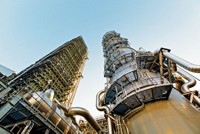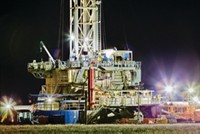Advertisement
Grab your lab coat. Let's get started
Welcome!
Welcome!
Create an account below to get 6 C&EN articles per month, receive newsletters and more - all free.
It seems this is your first time logging in online. Please enter the following information to continue.
As an ACS member you automatically get access to this site. All we need is few more details to create your reading experience.
Not you? Sign in with a different account.
Not you? Sign in with a different account.
ERROR 1
ERROR 1
ERROR 2
ERROR 2
ERROR 2
ERROR 2
ERROR 2
Password and Confirm password must match.
If you have an ACS member number, please enter it here so we can link this account to your membership. (optional)
ERROR 2
ACS values your privacy. By submitting your information, you are gaining access to C&EN and subscribing to our weekly newsletter. We use the information you provide to make your reading experience better, and we will never sell your data to third party members.
Physical Chemistry
Fracked Shale Could Sequester Carbon Dioxide
Environment: Wells depleted of natural gas could be filled with significant amounts of captured CO2 emissions from power plants
by Katherine Bourzac
September 18, 2013
The same wells that energy companies drill to extract natural gas from shale formations could become repositories to store large quantities of carbon dioxide. A new computer model suggests that wells in the Marcellus shale, a 600-mile-long formation in the northeastern U.S. that is a hotbed for gas extraction, could store half the CO2 emitted by the country’s power plants from now until 2030 (Environ. Sci. Technol. 2013, DOI: 10.1021/es401221j).

Although switching from coal-fired power plants to ones that burn shale gas could slow the growth of CO2 emissions, the overall demand for energy is increasing, so total carbon emissions will continue to climb, says Andres F. Clarens, an environmental engineer at the University of Virginia. Some researchers have proposed mitigating this trend by capturing CO2 at power plants and injecting it into deep saline aquifers, a process called geologic sequestration. But Clarens sees potential to sequester CO2 in depleted shale-gas wells.
Shale is not very permeable, so “these are not the most intuitive places to store CO2,” Clarens says. “It’s hard to get anything in or out of it.” But the hydraulic fracturing, or fracking, process used to extract methane could provide a way to pump in CO2. In the fracking process, pressurized liquid blasts the shale rock, creating cracks that allow the gas to seep out to the well. The network of cracks left behind could be filled up with CO2 before the depleted wells are sealed. The idea is appealing because it would not require building any new infrastructure to sequester CO2. For example, storing the emitted gas in saline aquifers would require new drilling. By putting CO2 back into depleted shale gas formations, Clarens says, “we could close the loop on carbon.”
To examine the feasibility of storing CO2 in shale, Clarens built a computer model to estimate how much the Marcellus shale could handle. One main input to the model is diffusivity—a measure of how readily methane comes out of wells in a particular shale formation. For wells in the Marcellus shale in Pennsylvania, the team used data from a state database to estimate diffusivity. This methane data is used to predict how readily CO2 would diffuse into the shale. The other main input to the model describes the gas-absorbing properties of organic matter, called kerogen, within shale, which have been studied experimentally by other groups. Micropores within kerogen store most of the methane in these formations. Clarens expects CO2 would move into these pores and adsorb to the kerogen surface.
The storage capacity numbers are encouraging, Clarens says. CO2 would move into the well much faster than methane comes out, and it would stay there. That’s good news, he says, because if it takes too long to get the gas underground, the process would be too expensive and impractical.
Based on the amount of gas the formation is expected to produce, he calculates that the Marcellus shale could store between 10.4 and 18.4 billion tonnes of CO2 between now and 2030. That amount is more than half of the expected total U.S. CO2 emissions from power plants over that time. And power plants account for about one-fifth of the country’s emissions. Clarens has started experimental studies on crushed shale to validate the storage potential predicted by the model.
Sarah Gasda, an engineer specializing in CO2-sequestration modeling at the Center for Integrated Petroleum Research in Norway, says storing CO2 in shale wells has potential and that the use of existing infrastructure is a good selling point. However, she cautions that the model does not consider several important factors, including the buoyancy of the gases, the heterogeneity of these kinds of formations, and the presence of water and other fluids, all of which will affect how much CO2 will be absorbed by fractured shale. But given the carbon problem in the U.S., “all options should remain on the table,” Gasda says.





Join the conversation
Contact the reporter
Submit a Letter to the Editor for publication
Engage with us on Twitter